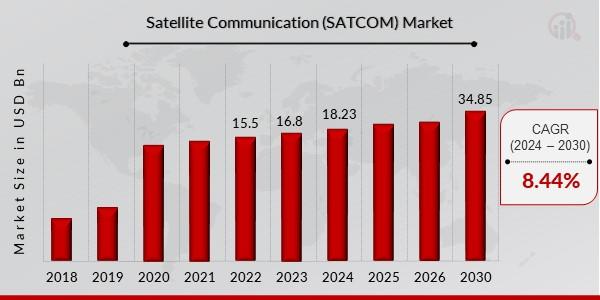Satellite Communication Market Set for Massive Growth Amid Rising Demand for Global Coverage

Power of Satellite Communication (SATCOM) Market
In an increasingly interconnected world, where seamless communication is vital, traditional terrestrial networks often fall short. Geographic barriers, remote locations, and the need for robust, ubiquitous connectivity necessitate a different approach. This is where Satellite Communication (SATCOM) steps in, leveraging artificial satellites orbiting Earth to relay signals across vast distances, connecting people and systems wherever they may be.
How SATCOM Works: A Celestial Relay Race
The fundamental principle of Satellite Communication is elegant in its simplicity. It involves three key components:
- Ground Segment (Earth Stations/User Terminals): These are the terrestrial facilities or devices that send and receive signals. They range from large parabolic dish antennas at fixed ground stations to small, portable terminals for mobile users, or even integrated antennas on vehicles, ships, and aircraft.
- Space Segment (The Satellite): The heart of the system, the satellite receives signals from an Earth station (the "uplink"), amplifies them, and then retransmits them back to Earth (the "downlink") at a different frequency to avoid interference. These satellites are equipped with transponders, which are essentially radio receivers, amplifiers, and transmitters.
- Communication Link: This is the path the signals take, comprising the uplink (Earth to satellite) and downlink (satellite to Earth).
Communication satellites operate in various orbits:
- Geostationary Earth Orbit (GEO): At approximately 35,786 km above the equator, GEO satellites appear stationary from the ground. This allows for continuous coverage of a large area with just a few satellites, making them ideal for broadcasting TV, stable internet connections, and long-distance telecommunications.
- Medium Earth Orbit (MEO): Located between LEO and GEO (around 7,000 to 20,000 km), MEO satellites offer a balance between coverage and lower latency, often used for navigation systems like GPS.
- Low Earth Orbit (LEO): These satellites orbit much closer to Earth (typically 160 to 2,000 km). While requiring large constellations for continuous global coverage, LEO systems offer significantly lower latency, enabling high-speed broadband internet with a responsiveness similar to fiber-optic connections.
Beyond Boundaries: Applications of SATCOM
SATCOM's ability to provide connectivity regardless of terrestrial infrastructure makes it indispensable across numerous sectors:
- Broadcasting: Television and radio signals are widely distributed via satellites, enabling direct-to-home (DTH) services and connecting remote broadcasters to global networks.
- Internet Access: For rural areas, maritime vessels, aircraft, and disaster zones where fiber or cable is unavailable, satellite internet provides vital connectivity. LEO constellations like Starlink are revolutionizing this by offering low-latency, high-speed broadband globally.
- Telecommunications: Long-distance phone calls, mobile backhaul, and emergency communications often rely on satellite links.
- Military and Government: Secure and reliable satellite communication is critical for command and control, intelligence gathering, surveillance, and tactical communications in remote or hostile environments.
- Disaster Management: When ground infrastructure fails during natural disasters, SATCOM provides the sole means of communication for relief efforts, damage assessment, and coordinating aid.
- Maritime and Aviation: Ships and planes rely on SATCOM for navigation, weather updates, operational communications, and increasingly, in-flight/on-board internet for passengers and crew.
- Remote Sensing and Earth Observation: Satellites constantly gather environmental data, weather patterns, and imagery, which is then transmitted via SATCOM to ground stations for analysis.
The Future of Connectivity: Trends in SATCOM
The SATCOM landscape is evolving rapidly:
- Mega-Constellations: The deployment of thousands of LEO satellites (e.g., Starlink, Project Kuiper, OneWeb) is transforming global broadband access, promising higher speeds and much lower latency.
- High Throughput Satellites (HTS): These satellites, in various orbits, utilize advanced technologies like spot beams and frequency reuse to deliver significantly higher data rates and capacity.
- 5G Integration: The convergence of satellite networks with 5G terrestrial networks is creating hybrid systems that promise seamless, ubiquitous connectivity, especially for IoT devices and mobile users in remote areas.
- On-board Processing: Satellites are becoming "smarter" with increased onboard processing capabilities, allowing for more efficient routing and management of data in space.
- Optical Inter-satellite Links (ISLs): Using lasers for communication between satellites reduces reliance on ground stations and further lowers latency for global data transfer.
- Miniaturization and AI: Smaller, more affordable satellites (smallsats) and the integration of Artificial Intelligence (AI) for optimized satellite operations are driving innovation and reducing costs.
- Art
- Causes
- Crafts
- Dance
- Drinks
- Film
- Fitness
- Food
- Games
- Gardening
- Health
- Home
- Literature
- Music
- Networking
- Other
- Party
- Religion
- Shopping
- Sports
- Theater
- Wellness

